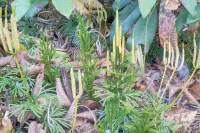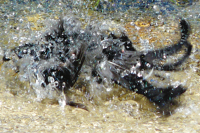The axe always forgets, the tree always remembers
 No matter how bad the storm, there will always be another rainbow. Donated photo
No matter how bad the storm, there will always be another rainbow. Donated photo
If a tree falls in the forest and no one is around to cut it up and use it for heat or timber, is it a waste of resources? Or, put another way, are humans the only reason that all other life on Earth was created?
My answer to both questions is no. We share this planet with many different kinds of neighbors, from the plants, trees, insects, birds and other animals, to fungi, bacteria and other microbes that live in the soil, to the water that courses through all things. But we in our modern culture tend to be selfish, thoughtless and uncaring neighbors.
I have been witness to a couple of major disturbances in the ecosystem lately and have been spending a lot of time thinking about disturbances, both their short-term and long-term harm, and their benefits. Often, a horrible tragedy can lead to beautiful changes. In fact, most everything that you know and love on this planet — wildflowers, poetry, song, art and even your friends, loves and family — are the direct result of the last mass extinction.
Everything is going to be OK, eventually.
That’s the thing with disturbances in our lives, both large and small. In the wake of tragedy, everything is destruction, desolation and loss, but when you zoom out, quite often, beautiful things develop as healing begins. This is as true in my personal life as it is in the forest. Of course, some disturbances and tragedies are not so small. But if we can take a long enough view of time, beauty and diversity always result.
In the study of ecological disturbance, a major event like a tree falling, a landslide, a flood, or in the case of the forest just above my home in Cullowhee last week, a rare mountain tornado, is actually a driver of the ecosystem and the health and diversity of the forest. During the tornado and storm, all was terror, and in the immediate aftermath, it is a seeming wasteland of destruction and debris. But the forest has already begun its recovery, and it was almost immediate.
Related Items
New openings of light have signaled small trees to begin the race to become the next forest giants to fill in the canopy once again. Fungal spores were already covering all of the trees, shrubs and flowers that were killed or damaged, and have begun their work of processing, decomposing and returning the energy of the fallen to the system that produced the now-fallen trees. Wildflowers, fed by the products of decomposition, will thrive in the new openings. And through these and other intricate and interrelated processes, the forest will not only recover, but it will also thrive.
However, other kinds of disturbance can have a negative impact on the ecosystem. Especially anthropogenic disturbance, those caused by modern humans and our machinations. A single mowing of a wildflower meadow every few years will increase the diversity of that meadow. However, repeated and constant mowing will reduce the meadow to a field, pasture, or lawn with very little diversity. Same is true for clearcut logging of timber, for excessive sprawl and development, as well as our large-scale industrial agriculture systems that turned the diverse prairies of the Midwest to millions of acres of corn, soy and wheat. This system is currently clearing the Amazon Rainforest and turning it into millions of acres of palm oil plantations and cattle pasture.
Our way of life is causing major disturbances to the ecosystem we share, the ecosystem that supports life-on-earth-as-we-know-it, of which I am a big fan. Over time, the earth will recover and flourish through this current mass extinction event. We witnessed the incredible regenerative nature of the earth during the pandemic lockdown. Nature returned to the cities and suburbs. Whales entered harbors which held no ships. To help save the world — and ourselves — we need to first stop the harm, and then we can help set up the initial systems that will allow the earth to heal itself. Because that is what she does. And she is very good at it.
When a tree falls in a forest due to storm or axe, there are plenty of eyes to watch it and ears to hear the thud, be they human or not, but the processes of healing and recovery are built into the system. I like to try and remember that those same systems of self-healing are also built into you and I, helping us to weather our own storms. Perhaps, we just need to get out of our own way and allow the healing to occur.
(Adam Bigelow lives in Cullowhee. He leads weekly wildflower walks most Fridays and offers consultations and private group tours through Bigelow’s Botanical Excursions. This email address is being protected from spambots. You need JavaScript enabled to view it..)













